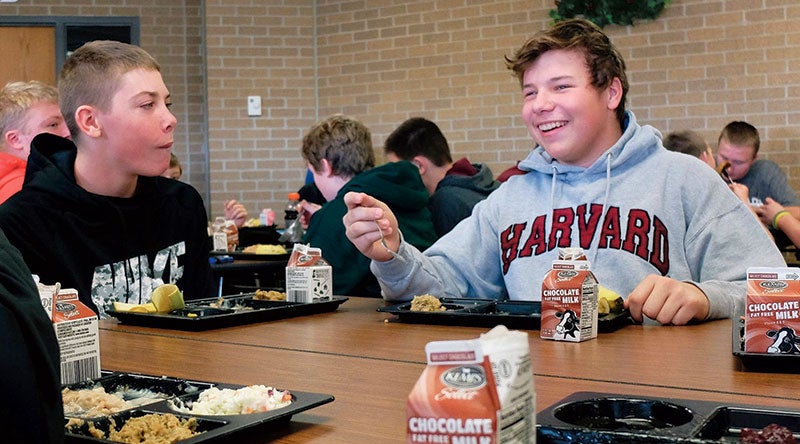Zucchini everywhere: School-grown produce teaches students to eat their veggies
Published 6:37 am Saturday, November 17, 2018

- Holdingford sophomore Grady Christopher, right, gives locally grown produce a mixed review. “I like the pickles,” he said while eating lunch in the school cafeteria on Oct. 24, 2018. Dan Gunderson/MPR News
By Dan Gunderson
MPR News/90.1 FM
When students at Holdingford Public Schools grab their lunch trays and dig in, they might be eating food they helped grow and harvest.
And some of those foods are a new experience for their taste buds.
“Our kids eat eggplant, they eat squash. They eat a lot of cabbage,” said the district’s food service director, Melissa Anderson.
If the students hadn’t been helping to plant and grow some of those vegetables, Anderson said, she’s not certain they would have shown up on their cafeteria trays.
“Those are some things that if we weren’t growing it ourselves, I don’t know that we would have even ventured into purchasing it, to see if they would even try it. The kids are eating things we didn’t think they would eat.”
And that adventure has made an impression on Holdingford’s students. High school freshman Brad Krebsbach said he’s learning to like new foods, like eggplant.
“Most the stuff they grow, I like it. It just has a different taste,” he said. “You can tell when something is processed that the school buys, between that and like the organic stuff they grow. It’s very nice.”
Holdingford started a garden in 2012 and later added a greenhouse. It’s one of only a few schools in the state that grows its own produce for its lunches — and Anderson said while the locally grown food isn’t a big money saver, it has increased healthy food choices for students and increased student interest in where the food they eat comes from.
But before the district’s 1,100 kindergarteners through high school seniors can try new foods, its cooks are learning how to use the new abundance of fresh produce.
“You have to know what you would possibly do with the items, and then have a little adventurous spirit to have to go ahead and try things,” Anderson said.
Step inside the school’s walk-in cooler and the bounty is evident: among the boxes of purchased food products are a couple dozen five-gallon pails of homemade pickles, boxes of cabbage — and loads of zucchini. The school has used a lot of zucchini this year.
“[We] put it in soups … muffins … we throw a little in scalloped potatoes,” Anderson smiled. “They can find zucchini everywhere.”
Anderson hopes to expand local school lunch offerings beyond the abundant zucchini and pickles and cabbage. She’s working on a project to have students who are members of FFA and live on farms raise beef or hogs for the school.
Growing their own food, Anderson said, doesn’t save the school money — or increase its costs. In the end, it comes out even: Processing the garden-grown food adds labor costs, which are offset by savings in the school’s food-purchasing budget.
Minnesota’s Department of Education doesn’t track how many schools grow their own food, but a U.S. Department of Agriculture survey in 2015 found that 47 percent of Minnesota schools have some kind of farm-to-school program to include local food on the menu. Only five schools reported growing their own food.
Few have taken the idea as far as Wadena-Deer Creek Public Schools.
The central Minnesota school has a high hoop greenhouse that extends the growing season by at least a month in spring and fall, and a deep winter greenhouse that grows lettuce, kale, radishes and other cool-weather crops all winter.
Caroline Venis runs the greenhouses. This time of year, she’s pulling up tomato plants, still covered in red and green fruit, to make room for lettuce.




